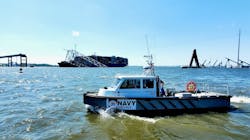Port of Baltimore’s Federal Channel Reopens
Eleven weeks since the collapse of the Francis Scott Key Bridge, the main passageway for the Port of Baltimore has been fully restored.
On Monday, Unified Command reopened the full-width Fort McHenry Channel where the bridge collapsed into the Patapsco River.
"One of our four key directives in the wake of the Key Bridge collapse has been to fully clear the federal channel," Maryland Gov. Wes Moore said in a statement. "Today, we bring that directive to completion. By working together, we turned months into weeks – and bounced back faster than many could have ever anticipated."
The 700-foot wide and 50-foot-deep channel will now allow two-way traffic for large vessels.
"We are proud of the unified efforts that fully reopened the Federal Channel to port operations," said Lt. Gen. Scott Spellmon, commanding general of U.S. Army Corps of Engineers, in a statement. "The partnerships that endured through this response made this pivotal mission successful."
The reopening of the Federal Channel was only achievable after almost 50,000 tons of bridge wreckage was removed from the river, according to a report from CBS News.
"We've cleared the Fort McHenry Federal Channel for safe transit. USACE will maintain this critical waterway as we have for the last 107 years," said Col. Estee Pinchasin, from the U.S. Army Corps of Engineers, in a statement to CBS. "I cannot overstate how proud I am of our team. It was incredible seeing so many people from different parts of our government, from around our country and all over the world, come together in the Unified Command and accomplish so much in this amount of time."
The wreckage from the Key Bridge will continue to be taken to Sparrows Point for "follow-on processing," the U.S. Army Corps of Engineers said to CBS News.
"When we started pulling up these pieces, they were enormous—some 50- to 80 feet long of wreckage that was still tied together and mangled," Pinchasin said. "So, we knew there were steel members below the mudline that we have to continue to pull out."
The salvage team then broke up the pieces at Tradepoint Atlantic.
"That's where we're downsizing the material we bring over there, and it's being sold for scrap and recycled," Pinchasin said.
Using sonar, lidar and a magnetometer, the Unified Command spent the past few days scanning underwater for the last bits of road debris and steel.
Now that the Port is on its way to being fully operational, the attention has turned to rebuilding the bridge.
“With the channel now fully open, we can get more Marylanders back to work at the Port of Baltimore, increase the flow of commerce through the city, and accelerate our economic recovery,” Moore said in a statement. “But our work is not over until we rebuild the Francis Scott Key Bridge.”
Source: CBS News, Wtopnews.com
